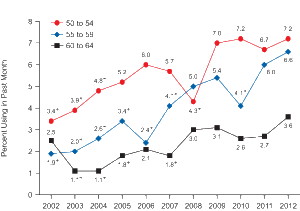Posted by azdrugrehabctr on November 21, 2013 under Synthetic Drugs | 
Last week the U.S. Drug Enforcement Administration (DEA) carried out its intent to place three more synthetic drug compounds on the Schedule I list as having no medicinal value and made them illegal. The compounds are powerful hallucinogens called synthetic phenethylamines.
The move from the DEA makes them outlawed for two years initially, at which point a decision can be made to have them become permanently illegal. According to a release the Administration, these drugs have been responsible for at least 19 deaths in the past year or so.
The abbreviate chemical names for the drugs are 25I-NBOMe, 25C-NBOMe and 25B-NBOMe and have reportedly been found in powdered form, liquid solutions on blotter paper and combined with edible items.
The DEA says that NBOMe compounds are substantially more potent than other hallucinogenic compounds, and the data suggest that extremely small amounts of these drugs can cause seizures, cardiac and respiratory arrest, and also death, as evidenced by the recorded loss of lives.
The continued pursuit of identifying and outlawing synthetic compounds have had the DEA constantly playing catch-up, and the aftermath caused by the new drugs in terms of damage to lives has been a difficult transition for treatment professionals. If you have a loved one in need of help for a problem with synthetic drugs of any kind, contact us today for treatment solutions.
Posted by azdrugrehabctr on November 12, 2013 under Prescription Drugs | 
 On October 26th, the DEA held its prescription drug take-back day. Although this was a nationwide event, the Phoenix DEA office reported that there were 90 collection sites around the state of Arizona, which netted more than ten thousand pounds of left over prescription drugs.
On October 26th, the DEA held its prescription drug take-back day. Although this was a nationwide event, the Phoenix DEA office reported that there were 90 collection sites around the state of Arizona, which netted more than ten thousand pounds of left over prescription drugs.
With over five tons collected that day, the total collected for the state over the past few years has been 29 tons (58,000 pounds). Prescription drug take-back programs have effectively discarded several hundred thousand tons of unused and unwanted medications. The idea is to help get them off the street and out of medicine cabinets to help prevent that type of substance abuse.
According to the DEA’s release, “Disposal of unwanted, unused or expired drugs is one of four strategies for reducing prescription drug abuse and diversion laid out in Epidemic: Responding to America’s Prescription Drug Abuse Crisis. The other strategies include education of health care providers, patients, parents and youth; enhancing and encouraging the establishment of prescription drug monitoring programs in all the states; and increased enforcement to address doctor shopping and pill mills.”
Posted by azdrugrehabctr on November 1, 2013 under Addiction Trends | 
 The latest results of the National Survey on Drug Use and Health (NSDUH) show that drug and alcohol abuse is rising among the Baby Boomer generation. The age group refers to people born between 1946 and 1964, which was after World War II.
The latest results of the National Survey on Drug Use and Health (NSDUH) show that drug and alcohol abuse is rising among the Baby Boomer generation. The age group refers to people born between 1946 and 1964, which was after World War II.
Adults between the ages of 50 and 64 have seen an increase in illicit drug use over the past decade. The rate for those aged 50 to 54 more than doubled from 3.4 percent in 2002 to 7.2 percent in 2012. Even more dramatic was the rate for the 55 to 59, which jumped from 1.9 percent up to 6.6 percent during the same time period. The rate for those aged 60 to 64 still more than tripled from 1.1 percent to 3.6 percent over the decade.
Alcohol and prescription drug abuse have been the biggest culprits in terms of substances. Currently there are about 2.8 million people over the age of 50 who are said to be in need of treatment for alcohol or drug abuse, and that number is expected to at least double within the next 7 years.
One of the major concerns is that as this generation continues to get older, the treatment requirements for substance abuse can become more difficult with additional medical problems that would need to be addressed, monitored or treated along with the behavioral health conditions.
Since Arizona has been a popular spot for retirees due to the warmer climate during winter months, treatment centers in the state have to become more prepared to deal with older populations needing rehabilitation services. If you have a friend or family member in need of drug abuse help in Arizona, contact us today.

 On October 26th, the DEA held its prescription drug take-back day. Although this was a nationwide event, the Phoenix DEA office reported that there were 90 collection sites around the state of Arizona, which netted more than ten thousand pounds of left over prescription drugs.
On October 26th, the DEA held its prescription drug take-back day. Although this was a nationwide event, the Phoenix DEA office reported that there were 90 collection sites around the state of Arizona, which netted more than ten thousand pounds of left over prescription drugs.
